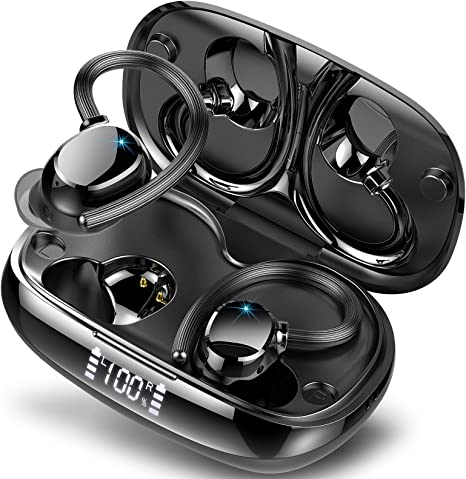The Signal Eater: Why Your Own Body Is the Biggest Enemy to Your Bluetooth Connection
Update on Oct. 11, 2025, 5:02 p.m.
It was a curious and, as he noted, “repeatable” observation. A man named Lloyd, reviewing his WUYI Q61 earbuds, discovered a strange glitch. The sound quality was great, the battery life solid. But, he wrote, “when I raise my arm up next my head and next to an earpiece, it will interfere with the bluetooth connection to my phone.” Every single time. It’s the kind of minor annoyance that most of us would shrug off as a quirk. But Lloyd’s observation isn’t a quirk; it’s a perfect, real-world demonstration of a fundamental principle of physics. It reveals that the single biggest obstacle standing between you and a stable wireless connection is, in fact, you.

To understand this mystery, we need to talk about the invisible world of radio waves. Your Bluetooth devices, along with your Wi-Fi router, your microwave oven, and your neighbor’s baby monitor, all operate in a narrow, bustling slice of the radio spectrum: the 2.4 gigahertz (GHz) band. This band is unlicensed, meaning companies can use it without paying for a dedicated frequency, which is why it has become the de facto home for personal wireless technology. But the 2.4 GHz frequency has a particular, fateful characteristic: it is exceptionally well absorbed by water.
This is no accident. It’s the very reason your microwave oven works. The oven bombards your food with 2.4 GHz waves, which energize the water molecules, causing them to vibrate rapidly and generate heat. Now, consider the human body. We are, for all practical purposes, walking, talking bags of saltwater, composed of about 60-70% water. From the perspective of a 2.4 GHz radio wave, you are not a person; you are a large, amorphous, signal-devouring obstacle. This phenomenon, known in radio engineering as “body blocking” or “body attenuation,” is the primary culprit behind countless dropped calls and stuttering songs.
So we’ve established that our bodies are walking, talking signal absorbers. But how does this scientific fact translate into that frustrating moment of silence? It’s a story of a signal’s incredibly perilous journey, a tiny epic that unfolds in milliseconds.

Imagine your phone is in your right pants pocket. It transmits a low-power Bluetooth signal, a whisper in the crowded 2.4 GHz airspace. That signal’s first challenge is to escape the pocket, losing some energy as it passes through the denim or cotton. Its next, and greatest, challenge is your body. If the receiving earbud is on your right side, the signal might have a relatively clear path. But if your primary earbud is on the left, the signal must attempt to travel through your torso. A significant portion of that signal’s energy is absorbed by the water in your tissues, just like a leftover burrito in a microwave. The signal that emerges on the other side is a faint, weakened version of what was sent.
This weakened signal then has to cross the open air to a tiny antenna embedded in your earbud. For this entire chain to work, the signal arriving at the earbud must be above a certain strength threshold. If it falls below that threshold, even for a moment, the connection drops.
Now, let’s return to Lloyd’s mystery. With his phone in his pocket and his arm at his side, the signal, while likely weakened, was just strong enough to maintain a connection. But when he raised his arm, he placed another water-filled obstacle—his bicep and forearm—directly in the signal’s path. This final barrier was the last straw. It absorbed just enough of the remaining signal to push it below the critical threshold. Connection lost. The repeatable experiment wasn’t a flaw in the earbuds; it was a perfect validation of physics.
If our own bodies are the villain in this story, short of changing our fundamental biology, what can we do? Fortunately, the engineers who design Bluetooth technology are acutely aware of this problem, and they’ve developed some clever tricks to fight back.
Modern standards like Bluetooth 5.3 incorporate features designed to make connections more robust. For instance, “Adaptive Frequency Hopping” allows the signal to rapidly jump between dozens of different channels within the 2.4 GHz band. If one channel is noisy or getting blocked, it can quickly hop to a clearer one. More efficient data encoding also helps, allowing more information to be packed into a weaker signal, making the connection more resilient to attenuation. Engineers also work on antenna design, trying to place these tiny components in the optimal spot on an earbud to “hear” the signal, no matter which direction it’s coming from.
Tips for a More Stable Connection * Know Your Primary Bud: Most true wireless earbuds have one designated “primary” that communicates with the phone (often the right one). Try keeping your phone in a pocket on the same side of your body as the primary earbud. * Avoid Deep Storage: In challenging environments like a crowded gym, avoid keeping your phone in a backpack or a back pocket, which forces the signal to travel through more of your body. An armband or a front pocket is usually better. * Expect Interference: In places with many other people (and their phones), the 2.4 GHz band is chaotic. Occasional dropouts are a normal consequence of the physics of our wireless world.
The invisible sea of radio waves we navigate daily is governed by immutable laws. Our technology, no matter how advanced, must still obey them. Lloyd’s simple act of raising his arm pulled back the curtain on this hidden reality, reminding us that even in our hyper-connected age, we are still gloriously, stubbornly, wonderfully physical beings, living in a very physical world.




















